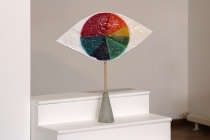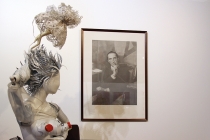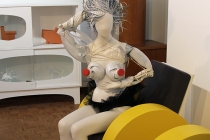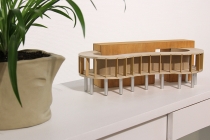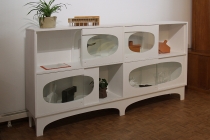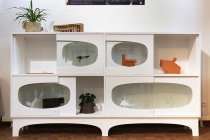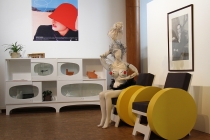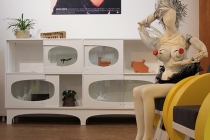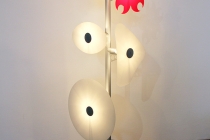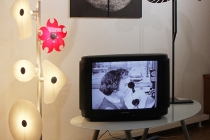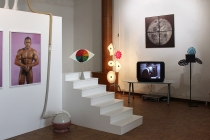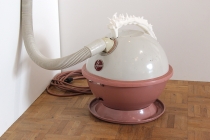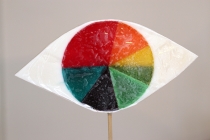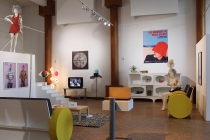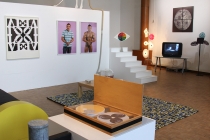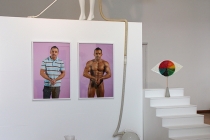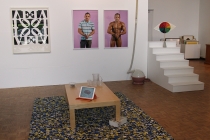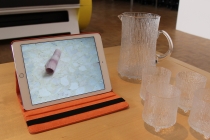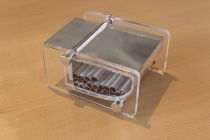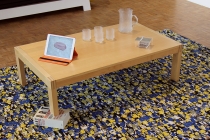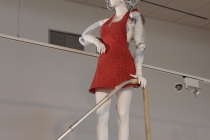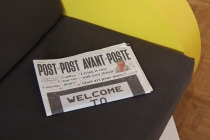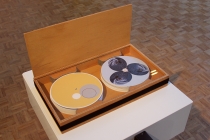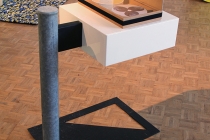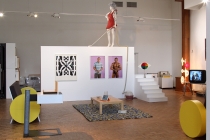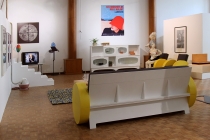Group exhibition.
Artothèque de Vitré.
26th April to 19th July 2019.
David Michael Clarke with Valentin Alizer, Patrice Carré, Dominique Delpoux, Tristan Diguet, Christelle Familiari, Nils Guadagnin, Jean-Olivier Hucleux, Anabelle Hulaut, Robert Indiana, Christian Marclay, Pascal Mirande, Marion Norman, Pauline Pô, Atelier Polyhedre, Babeth Rambault, Tapio Wirkkala.
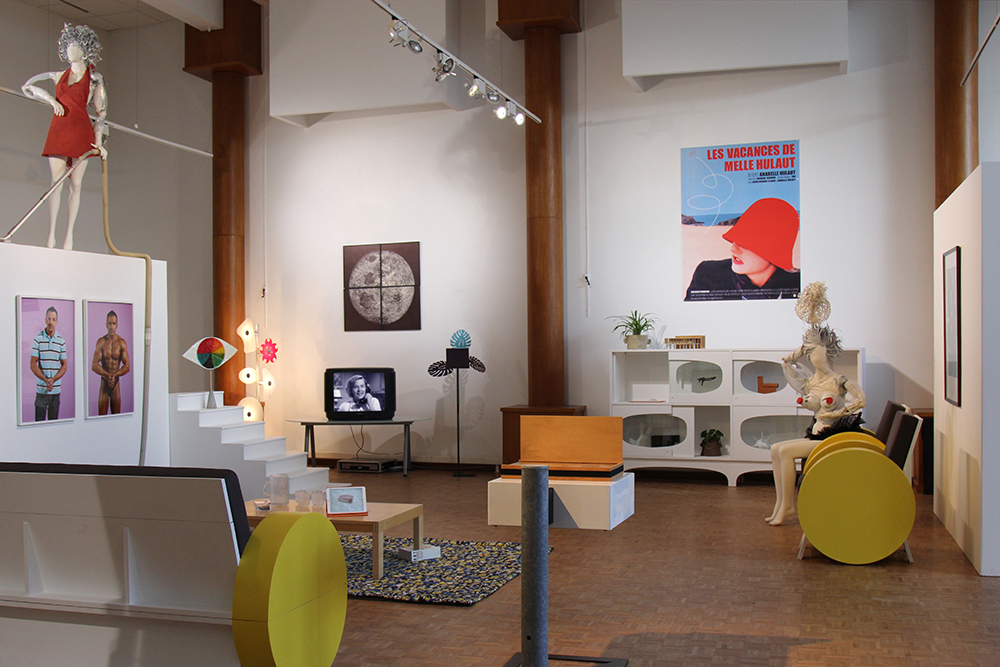
The exhibition takes as its starting point the celebrated collage, Just what is it that makes today’s homes so different, so appealing ? created by Richard Hamilton in 1956. In order to evoke each constituant element of the image, and to weave together the complex of relations that persist in our homes, today as yesterday and yesterday as tomorrow, I didn’t only lean on my own practice, I looked at the other artistic talents that surround me, in the collection of the Artothèque de Vitré, at the FRAC Bretagne, and even at the Museum of Modern Art, le Centre Georges Pompidou.
The exhibition is tied to a context, encounters, and discussions that traverseart history and some more personal tales. About three years ago, when I began this residency, Isabelle Tessier, directrice of the Artothèque de Vitré, told me that the « lending space » was to be reorganised so as to house a new exhibition space. One of the hypothesis under discussion was the construction of a mezzanine ; the gallery would thus comprise two floors with a staircase allowing passage from one level to the other. Imagining this staircase as a feature of the future exhibition space led me to thinking about Hamilton’s collage, and I started to elaborate ideas about an exhibition that was both domestic and composite.
The furniture :
In order to define the exhibition space and to evoke each element constitutive of the original image, I started to design some furniture, notably a pair of armchairs and a sofa-bed. It’s not habitual to sleep in an art exhibition. However, to date I have spent two nights sleeping in such a context. The first time, it was Anabelle Hulaut who invited me to spend the night in her exhibition,Villa Dourven. The second time, it was in Nègrepelisse during my exhibition Madame Orain et la Mogette Magique. On this occasion, I integrated two bunk beds into the exhibition’s principal architectural structure.
In general, I find sofa-beds to be visually heavy, cumbersome. This is no doubt due to the massive volume required to house the folding mechanism. I wanted to propose something lighter and more sculptural like the series, Westside by designer Ettore Sottass. This furniture is constituted in the main of rectangular and triangular forms. I decided to integrate the circle.
The vitrine that I designed was inspired both by the television in Hamilton’s collage, but also by a social housing scheme known as « Maison Rouge » that can be found in the southern district of Vitré.
The second constitutive element that I wanted to take on is the rug. For his collage, Hamilton evoked the texture of the carpet by using a quasi-aerial photograph of sun-bathers on Whitley Bay beach, near Newcastle, England. This place resonnated personally for me as my grandma spent her teenage in this town and she told me some of her intrepid stories. Today, most of the aerial photography that I see is either of rock festivals or political demonstrations. In 2016, as this project began, the activists in my home country were busy marching for or against « Brexit ». The pro-Europeans manifested their political allegiance by wearing yellow and blue outfits. I set to drawing one such march, pixel by pixel, and then through collaboration, to weaving a grand tapestry in the town of Felletin.
The figures :
Two central figures occupy the space of Hamilton’s collage : the erotic figure of the perfect woman, the canon of beauty for the times, and the figure of a strongman, a bodybuilder swinging a giant lollipop as if it were a tennis racket. In the Artothèque de Vitré collection, Isabelle Tessier showed me a photographic diptych by the artist Dominique Delpoux representing a bodybuilder in full competition and relaxed in his everyday clothes. I had already met Dominique Delpoux during a visit to Occitanie. His work raises essential social questions as it examines identity, time and difference.
In Hamilton’s collage, the figure of the woman appears several times. The central figure is a representation of the erotic woman, nearly nude, seated on a sofa with a lampshade on her head. She is an « object » to be owned, a « trophy wife » to show off. She is simply part of the decor. A second representation of the woman can be found at the top of the stairs. She is the perfect housewife, happily « hoovering » as she goes. The third representation of the woman is on the TV screen ; smiling on the telephone, the ideal receptionist. Visibly, Hamilton is refering to the social context of the 1950s and the impossible pressure placed upon women. As the model Jerry Hall will say some years later « My mother said it was simple to keep a man, you must be a maid in the living room, a cook in the kitchen and a whore in the bedroom ». To reflect and react to this question of the representation of the woman, I asked the stylist Pauline Pô, who often works with recycled material, to create something new, inspired by the spirit of Hamilton’s collage.
In the collage, the woman at the top of the stairs (no doubt a reference to Marcel Duchamp’s masterpiece Nude descending a staircase, 1912) is attached by an extra-long tube to a revolutionary vacuum cleaner : the Hoover Constellation. This cleaner used the force of the evacuated air to produce an air-cushion on which it floats like a hover craft. Production began in the nineteen-fifties and continued well into the eighties. I managed to get my hands on two of the early models. One is in very good condition, the other needed a new handle. The original handle is sculpted and aerodynamic. I decided to ask one of my students, Tristan Diguet, to use the new technologies that we now have at our disposition to create a new handle for the the 21st century.
The third woman in the collage brought to mind instantly a specific work of art. In 1995, the american artist Christian Marclay created on of his masterpieces, Telephones, a short video edited from several clips cut from mainly Hollywood feature films. The actors are progressively overtaken by the telephone, who becomes the « real » star of the work. This video is loaned by the Centre Georges Pompidou.
The objects :
In Hamilton’s collage, at the feet of the bodybuilder, one can see an old reel-to-reel tape-recorder. This machine, product of the British manufacturer of musical instruments, Boosey & Hawkes, made me think instantly of the artist, Patrice Carré. His work rebounds constantly between sculptural volume and the volume of sound. I first discovered his work at the home of Amélie and Joël Hubaut. Patrice was one of Joël’s early students. During the summer of year 2000, I had the chance to live in one of Patrice’s works. He had modified a house for an event called Parcours Contemporainin the town of Fontenay-le-Comte. At the same moment, Anabelle Hulaut and I had been named artists-in-residence in the same town, and as a consequence, we lived in this altered domicile. The shutters of our bedroom window had been mechanized to open and shut like winking eyes all day long. Our lounge was a sculptural installation. The first time I met Patrice in person was at the opening of the exhibitionOxymoryin 2003, organized by Joël Hubaut in the Pavillon de Normandie, Caen. Our conversation is still fresh in my mind, sitting as we were on the edge of a quay, our legs swinging in the void. Since then, Patrice and I have crossed paths on numerous occasions, exhibitions and residencies : first at the Galerie du Dourven in Brittany, then with the FRAC Normandie Caen, where we were both invited to make consecutive residencies. Searching for a work to evoke the « vintage » tape-recorder, we finally settled on Les rotos de l’été, created in 2008 and conserved at the FRAC Bretagne.
In the middle of the lounge, as it is represented by Hamilton, a coffee table is endowed with a plethora of objects : a coffee cup, a paper aeroplane, a candle holder, some books, a rather surprisingly large tin of ham. As an echo, I decided to reactivate an old sculpture callled Life after John that I made in 2002. I made it as a hommage to John Calcutt, who was the art theory teacher at Glasgow School of Art and an emblematic figure on the Scottish art scene. I often reactivate old works from my portfolio and this time I decided to change certain elements of the piece for objects that resonated more precisely with Hamilton’s collage.
On the table, I placed a video by artist Babeth Rambault who is above all known as a sculptor. Her material of predilection is often found abandonned on the pavement and her gestures are more often than not rudimentary. Her eyes are trained to spot the absurd. In this video, a slice of ham unrolls itself again and again as a voice repeatedly announces the tautologic declaration, « jambon ». The voice is rhythmed by the elasticity of the cooked meat. Rambault’s video is easily as enigmatic as the tin of ham in Hamilton’s original collage.
The presence of the water jug and tumblers by Tapio Wirkkala, the celebrated Finnish designer is more anecdotic but reveals nonetheless certain perspectives on my artistic journey, from my youth until today. Tapio Wirkkala is above all known for his furniture and his glass objects. He was awarded the grand prize at the Milan Triennale in 1951. He then went on to design Ultima Thule, a glass service for the Finnair’s first class cabin. I discovered the work of Tapio Wirkkala and other creative scandinavians during my school days thanks to my teacher, Marion Norman. Last year, as part of my residency, I accompanied Isabelle Tessier to Rendez-vous à Saint-Briac, a contemporary art festival in Brittany. I was to show one of my films. During our stay, we discovered this water-jug by Wirkkala rather incongously in one of the cupboards in our rented apartment. Seeing my interest for this object , Isabelle made an offer to the landlord and then offered the jug to me as a souvenir. Sometime later, during a telephone call, I told Marion about the jug. She said to me, « Next time you come to visit, I’ll give you the tumblers that go with it ». So this collection of glass objects represent two women, two strong figures that have accompanied me during important moments in my artistic adventure.
On my table, there is also a small box made from perspex and silver. It’s something that Marion made whilst studying at Hornsey College of Art, London, in the sixties. I rediscovered Marion’s work recently whilst visiting her in her new house. This « cigarette box » was damaged. I recovered the pieces and brought themback to my school in Le Mans. With the help of our new digital machines, I was able to reproduce and replace the broken bits. Doing this made me think of Richard Hamilton again. Hamilton studied the work of Duchamp in detail. The young artist considered him as a « master ». When Duchamp’s masterpiece, The Large Glass, failed, it was Hamilton who was charged with its restoration.
In the vitrine, one can find a selection of ceramic objects evoking two distinct artistic approaches, that of Christelle Familiari and that of Baptiste Ymonet & Vincent Jousseaume, who work together under the name « Atelier Polyhedre ». Christelle’s work is very intuitive, related to the human body and the gestures that it can make. In the early days of her artistic career, her production of handmade objects was associated with performances that combined both personal and political sentiments. Today, having undertaken a long period of research into form and material, she produces hybrid objects that play with both sculptural and functional qualities. The work of Baptiste and Vincent is more conceptual in its origins and then elaborated through working drawings followed by studio experiments with form and material. Their composite work often comprise geometric (although sometimes organic) shapes, combined with other more familiar forms hailing from our everyday environment. The resulting surreal universe is both surprising and troubling. In 1999, when I arrived in France, Christelle was a recent graduate of the fine art school in Nantes and Vincent was still finishing his studies in the same school. They were amongst my first artistic encounters on the continent.
In the furthest corner of the lounge, Hamilton decided to place a floor lamp topped by a large lampshade sporting the heraldic crest of « Ford ». Despite the fact that I am a biker, I am no fan of motorsports or the petrochemical world. In fact the opposite would be more true. And so I found myself rather stuck when it came to this object. However, last year, while I was clearing out my father’s old garage, I came across the bumper-badge for the universal exhibition, Osaka 1970. The exhibition was masterminded by the great « metabolist » architect, Kenzo Tange. Tange sought to bring together the all the wisdom of all the world’s peoples, to create a place to stimulate and exchange ideas. Although my father travelled constantly for his work, I was surprised that he would have bought such a badge to attach to his car. In the artothèque, I discovered a modern floor-lamp created by the Italian designer Ferruccio Laviani in 1992. It’s one of my favourite lamps because it reminds me of the paintings of Jean Arp. The lamp is fronted by five glass plaques, but sadly one of them had failed. I decided to adapt the Osaka 1970 logo, so that is could be used as a replacement for the missing glass.
The images :
Through the association of ideas, I decided to include a portrait of Marcel Duchamp in the place of the victorian portrait hanging on the yellow wall in Hamilton’s collage. Nobody seems to know who he is or where the image comes from. Whatever, I think we can agree that he represents an ancestor. After some thought, I said to myself : « For Hamilton, who could represent the previous generation better than Marcel Duchamp ? » Thus I chose another work from the artothèque’s collection, a lithography print by Jean-Olivier Hucleux, dated 1986.
Also from theartothèque’s collection, I decided to include a screen-print by Robert Indiana. The main reason, no doubt tied to my apparent eternel optimism, is because I wanted to replace the word « romance » by the word « love ». The second explanation is a story of multiple cover versions. In 1992, taking advantage of advances in digital technology, Hamilton himself, made an updated version of his collage. In this second version, Hamilton incorporated an image made by the Canadian artist collective, General Idea, who themselves, at the end of the eighties, had covered the American artist’s most celebrated work : Indiana’s Lovebecoming General Idea’s Aids.
Returning to the lounge as it is represented by Hamilton, two windows lend a view to the street outside. Across the road, one can perceive a cinema. The film being shown is The Jazz Singer, the first « talking picture » made in 1927, the film that announced a new modern era for the seventh art. Hanging in the middle of the other wall, a comic-strip cut-out becomes the poster, « Young romance ». The combination of these two elements seen alongside Hamilton’s critique of the woman’s place in society, les me to think about Anabelle Hulaut and her film project, Les Vacances de Melle Hulaut. Anabelle possesses that rare reflex of being able to « see and think differently », like a detective. Her thinks of her sculptures as films and her films as sculptures. Thus her world is one in which anything becomes possible, Utopia within reach.
The lounge, in the original collage, has no ceiling, nor roof. It is open to the night sky, only with a view blocked by a gigantic planet. It is in fact the planet Earth, seen from a satellite. In 1956, man was still to walk on the moon, but the « space race » had long since begun. Isabelle Tessier told me about the artist Pascal Mirande, who also happened to be a great Tintin fan. Inspired by Hergé’s Objectif Lune, Pascal started doing monumental biro drawings of the moon and was kind enough to lend us one for this exhibition.
The plants :
In Hamilton’s collage, as well as all the objects, there are two plants : a small table plant that I am unable to identify, and a giant cheese plant or Monstera Deliciosa. As I reflected on how to evoke the natural world in an artistic manner, I received an email from my friend Nils Guadagnin with news of his latest creations. The image on an enigmatic sculpture jumped out at me, and I contacted Nils directly to ask him to lend it. Nils is as interested by a small delicate object, capable of being lifted by a gentle breath, as he is by a tree that migh be uprooted by a hurricane before being dropped on a house.
The newspaper :
On one of the armchairs in Hamilton’s collage, a newspaper has been left, seemingly forgotten. I decided to publish a newspaper as a sort of « exhibition within an exhibition », a publication that would carry fresh news of tomorrow’s artists. I contacted Valentin Alizer, a young graduate from ESAD-TALM, the art school where I teach, and asked him to act as editor-in-chief and contact other ex students to participate in this unique project. Thus the publication of this journal is the occasion to gather together several generations of young artists that I have been able to get to know over the last eighteen years, as a glance into the future.
Texte: David Michael Clarke.
Translation (French to English): David Michael Clarke.
Also See:
Sunnyside furniture
The Vitrine of Vitré
Tapestry for Europe
Orbital Osaka Banpaku
Post-Post Avant-Poste
Life after John
Holophane Judd
Links:
L’Artothèque de Vitré
Ecole supérieure d’art et design, Tours Angers Le Mans
Valentin Alizer
Patrice Carré
Dominique Delpoux
Christelle Familiari
Nils Guadagnin
Anabelle Hulaut
Robert Indiana
Pascal Mirande
Pauline Pô
Atelier Polyhedre
Babeth Rambault

